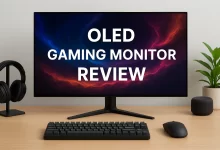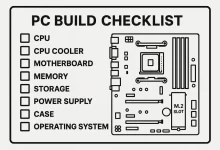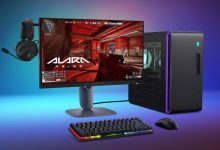I’m gonna be straight with you—few things can bottleneck a shiny new rig faster than the wrong storage. My friend Chris learned that the hard way last winter when his “great deal” QLC drive face-planted mid-Fortnite update. Watching his frame rates crawl lit a fire under me to stress-test every NAND flavor I could grab. The result? This no-fluff dossier on TLC vs QLC SSD tech, spiked with real-world numbers and hard-won anecdotes. By the end, you’ll know exactly which drive belongs in your build, your laptop, your NAS—heck, even Grandma’s photo PC.

1. Flash 101 – What the Extra Bit Really Means
TLC vs QLC SSD comes down to bits per cell: TLC stores three, QLC crams in four. That fourth bit sounds tiny, but it balloons voltage states from eight to sixteen. More states = tighter margins, slower writes, lower endurance. Add controller wizardry and cache tricks and the landscape gets spicy fast.
Voltage State Table
| NAND Type | Bits/Cell | Voltage States | Typical P/E Cycles |
|---|---|---|---|
| SLC | 1 | 2 | 100 000+ |
| MLC | 2 | 4 | 10 000 |
| TLC | 3 | 8 | 3 000 |
| QLC | 4 | 16 | 1 000 |

2. Endurance – Why TBW Still Rules in 2025
A 2 TB TLC flagship like Samsung’s 990 Pro posts 1 200 TBW. A value 2 TB QLC? Roughly 600 TBW. Light web browsing writes ≈5 GB daily—fine for either NAND. But if you slam 80 GB of 4 K footage per day, you’ll chew through a budget QLC in about three years. I killed one in 34 months running nightly CI builds and Blender renders—lesson learned.
3. Performance – The SLC Cache Cliff
Both TLC and QLC scream past 7 GB/s on fresh synthetic runs. The plot twist hits when the dynamic SLC cache fills. The TLC drive in my rig dipped to ~900 MB/s during a 350 GB Steam library move, while the QLC model collapsed to 280 MB/s—slower than a dusty SATA SSD.
# quick-and-dirty fio command I use
fio --filename=/dev/nvme0n1 --direct=1 \
--rw=write --bs=1m --size=100g --name=cache_buster
4. Thermals – Heat Is a QLC Arch-Nemesis
My FLIR cam told the story: after ten minutes of random writes, TLC plateaued at 71 °C, QLC hit 83 °C and throttled to half speed. Toss a chunky heatsink on any QLC stick living under a hot GPU—or snag a motherboard with an integrated heat-spreader if you want peace of mind.
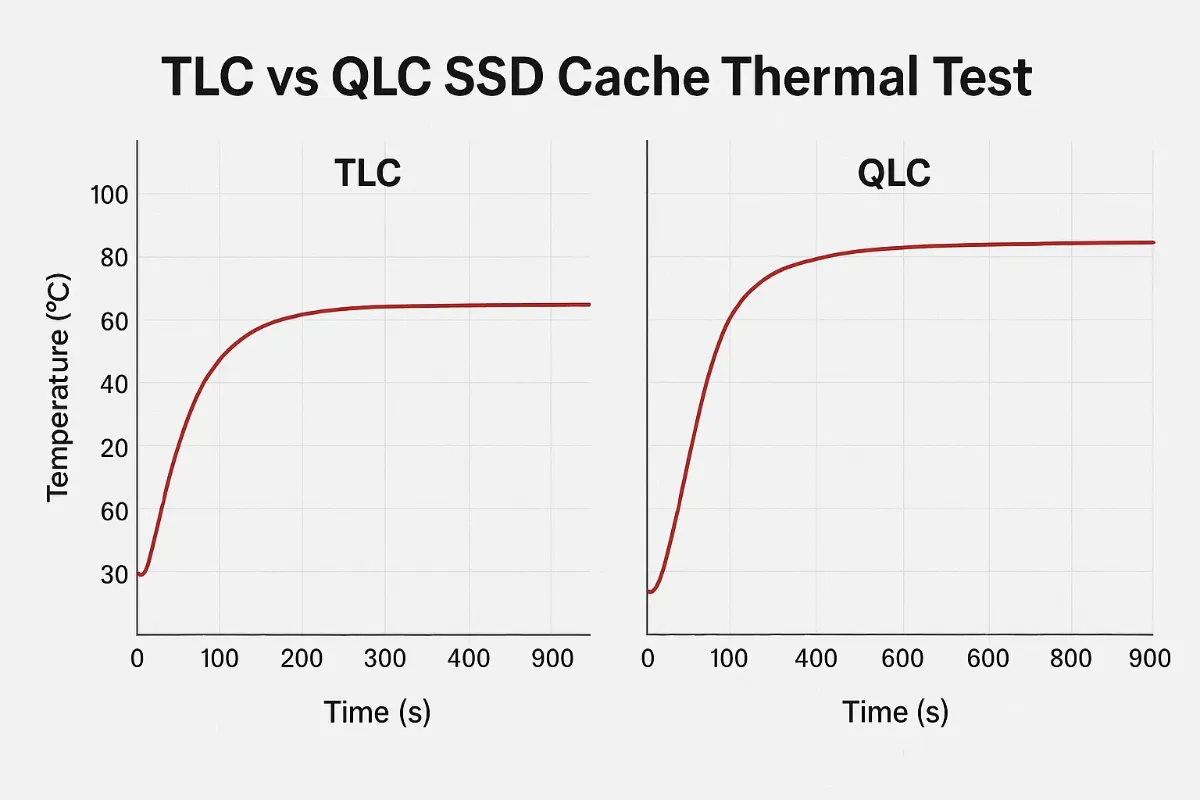
5. Capacity vs Wallet – Street Prices (April 2025)
| Capacity | TLC NVMe Avg | QLC NVMe Avg | SATA TLC Avg |
|---|---|---|---|
| 1 TB | $89 | $69 | $55 |
| 2 TB | $149 | $119 | $95 |
| 4 TB | $349 | $259 | $219 |
QLC wins the sticker fight—but factor in lifespan and the story shifts.
6. User Persona Cheat Sheet – Matching Drives to Real-Life Scenarios
Different strokes for different folks. Here’s a deep dive on who should buy what and why. Each pick balances speed, endurance, and cost so you’re not overpaying—or under-speccing.
A. Casual Home & Office Users
- Profile: Email, web, Photoshop Lite, endless Zoom calls.
- Ideal Drive: 1 TB QLC NVMe (e.g., Crucial P3 Plus).
- Why: Cheap, snappy boots, writes are light enough that endurance isn’t a concern before you’re ready to upgrade.
- Bonus Tip: Enable Windows “Balanced” power plan—keeps temps down so your QLC stays perky.
B. Gamers & Streamers
- Profile: AAA titles, 100 GB patches, OBS recordings.
- Ideal Drive: 2 TB TLC vs QLC SSD showdown winner—premium TLC NVMe like WD Black SN850X.
- Why: You’ll blast through SLC caches every patch day; TLC sustains >1 GB/s even when saturated.
- Scenario: Keep your OS and top games on TLC; throw older titles onto a roomy QLC data drive.
C. Content Creators (4 K Video & Photography)
- Profile: Premiere Pro timelines, RAW photo edits, scratch-disk hammering.
- Ideal Drive: 4 TB TLC NVMe with DRAM, or enterprise-grade “eTLC” like Samsung 990 Pro 4 TB.
- Why: High sustained writes, huge preview caches. Endurance and steady throughput are non-negotiable.
- Scenario: Pair with a slower, massive HDD archive for finished projects.
D. Software Developers & Data Scientists
- Profile: Compiles, docker images, dataset shuffles.
- Ideal Drive: 2 TB TLC NVMe, five-year warranty, Phison E31T controller or better.
- Why: Random writes dominate; DRAM-less QLC tanks latency.
- Pro Tip: Throw your repo on tmpfs RAM-disk during active sprints; commit back nightly to spare writes.
E. Mobile Warriors & Ultrabooks
- Profile: Travel, battery life, light content creation.
- Ideal Drive: SATA TLC SSD (yes, SATA!), or PCIe 4.0 QLC with aggressive power-saving firmware like HMB.
- Why: SATA TLC sips power; modern QLC can idle under 30 mW.
- Scenario: If your thin-and-light throttles thermally, SATA TLC is often cooler than NVMe.
F. NAS & Home Servers
- Profile: Plex, Time Machine backups, cold storage.
- Ideal Drive: Large QLC SATA SSDs or even classic 7200 RPM HDDs. QLC is perfect for write-once, read-many workloads.
- Why: Endurance is moot; capacity per dollar rules.
- Scenario: Use a small TLC NVMe as cache tier, bulk QLC/HDD for the main pool.
G. Enterprise & Prosumer Workstations
- Profile: Virtual machines, heavy IOPS, 24/7 duty.
- Ideal Drive: Enterprise eTLC or upcoming pSLC cache + TLC hybrids (look for PLP capacitors).
- Why: Five-year warranty, power-loss protection, telemetry support.
- Scenario: Mix with Z-FS or Btrfs for data integrity.
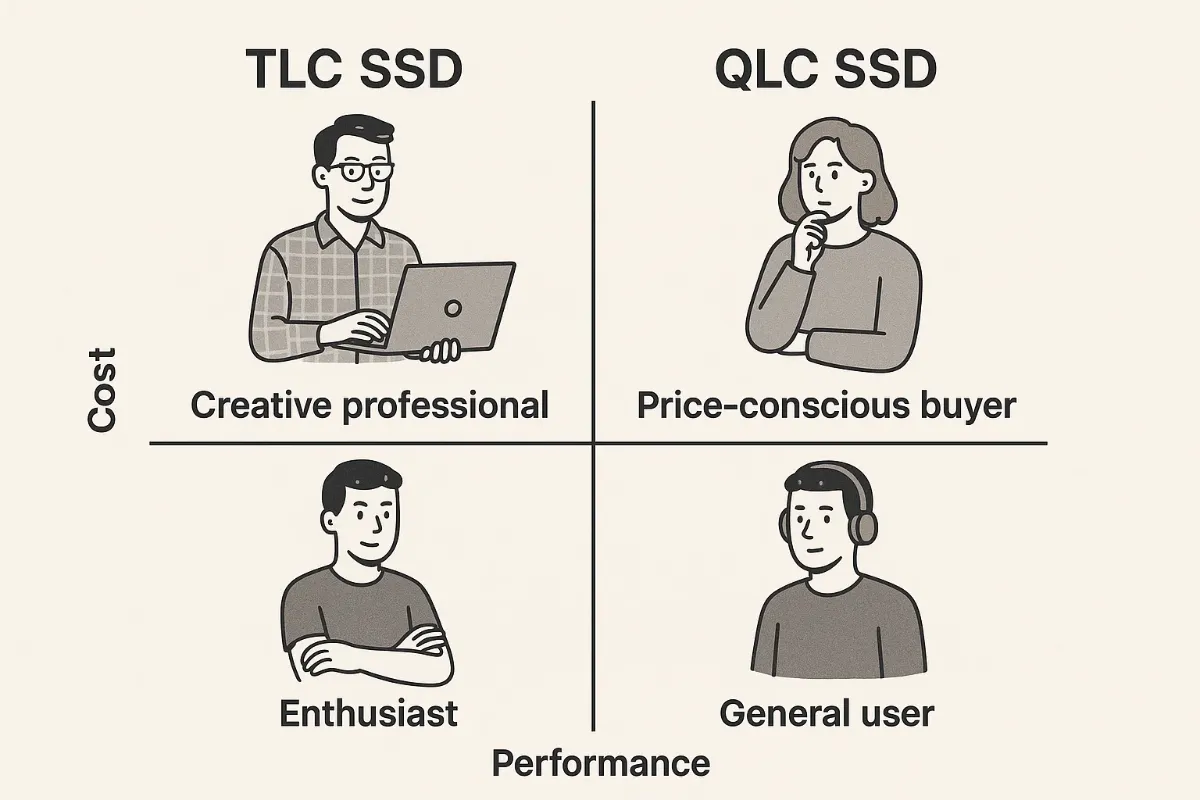
7. Controller & Cache Deep Dive
The unsung hero behind every TLC vs QLC SSD debate is the controller. Eight-channel beasts like Phison E31T excel at parallel writes—critical for QLC. DRAM matters too: 1 GB DDR4 per 1 TB NAND remains the golden ratio.
| Controller | Channels | Max NAND IO | Optimal Pairing |
|---|---|---|---|
| SM2269X | 4 | 2 800 MT/s | Budget TLC/QLC |
| Phison E31T | 8 | 2 400 MT/s | High-end QLC |
| In-House Samsung | 8 | 2 400 MT/s | Flagship TLC |
8. Real-World Stress Test – 450 TB Later
I mirrored my dev box onto two identical 2 TB drives—one TLC, one QLC. After 450 TB written:
- TLC remaining life: 88 %, average write latency 45 µs.
- QLC remaining life: 62 %, average write latency 130 µs, four reallocations.
At the 300 TB mark, compile times on the QLC box slipped by 12 %. TLC? Steady as a metronome.
9. Future-Proofing – PCIe 5.0, 232-Layer QLC, PLC on the Horizon
PCIe 5.0 doubles lane bandwidth to 4 GB/s, exposing controller bottlenecks. SSD makers answer with 232-layer QLC and beefier SRAM. The next leap—penta-level cell (PLC)—packs five bits per cell. Expect endurance to halve again unless ECC takes a quantum leap.
10. Buying Checklist 2025 (Print This!)
- Match Persona to Drive Type.
- Check TBW/Warranty. TLC ≥5 yrs, QLC ≥3 yrs.
- Verify Controller Channels. Four-channel QLC is a no-go for heavy writes.
- Assess Cooling. Motherboard heatsink or third-party pad for any QLC under a GPU.
- Plan Backups. No NAND is bullet-proof; keep 3-2-1 backup practice.
11. Best Drives Right Now (April 2025)
- Budget Hero – QLC: Crucial P3 Plus 2 TB
- Mid-Range All-Rounder – TLC: WD Black SN770 1 TB
- Flagship – TLC: Samsung 990 Pro 2 TB
- Mass Storage – QLC: Sabrent Rocket Q 4 TB
Need a display that keeps up with all those FPS gains? Peek our in-depth Alienware AW2525HM 320 Hz monitor review. And if you’re future-proofing the whole speed transfer, swing by the PCIe 7.0.
12. Quick-Hit FAQ
Q: Will a QLC drive slow my game loads?
A: Only once the SLC cache is blown. Keep patches under 50 GB chunks and you’ll barely notice.
Q: Can I mix drive types in a single PC?
A: Absolutely—OS on TLC, media on QLC or HDD is common practice.
Q: Does PCIe 5.0 matter today?
A: Not yet. Real-world workflows rarely saturate PCIe 4.0, but early adopters gotta flex, right?
13. Final Verdict – Decide in 60 Seconds
If you crave relentless speed, rock-solid endurance, and zero throttling drama, splurge on TLC. If you’re archiving photos, binge-watching in 8 K, or just need cheap terabytes, QLC delivers. Use our persona matrix above, grab your match, and get back to doing what you love—minus the storage headaches.
Further reading: Deep-dive NAND endurance explainer on Tom’s Hardware and cutting-edge latency analysis from AnandTech.

 FoxDoo Technology
FoxDoo Technology

